Indian Weddings
Creative and Budget-Friendly Haldi Ideas
Donec sollicitudin molestie malesuada. Nulla porttitor accumsan tincidunt. Vestibulum ante ipsum primis in faucibus orci luctus et ultrices posuere cubilia Curae; Donec velit neque, auctor sit amet aliquam vel, ullamcorper sit amet ligula. Vestibulum ac diam sit amet quam vehicula elementum sed sit amet dui.


What you need for your at home celebration:

Floral Wall Backdrop:

Quirky Photo Booth:
Set up a DIY photo booth with props like oversized sunglasses, funny mustaches, and colorful hats for guests to enjoy. Use a vibrant fabric or a floral backdrop to make the photos pop.

Colorful Fabric Draping:
Drape your walls, ceiling, or furniture with bright, patterned fabrics like Bandhani, Leheriya, or Ikat to create an instant festive vibe. Mix and match colors like yellow, orange, pink, and green for a vibrant look.

DIY Tassel Garlands:

Low Seating Arrangement:

Lanterns and Candles:
Shopping Checklist:
Turmeric powder
Sandalwood powder
Rosewater
Coconut oil
Rice flour
Haldi kumkum plate
Bandhani, Leheriya, or Ikat fabrics for draping
Vibrant colored cotton or silk fabrics
Patterned or floral print fabrics
Fresh flowers (marigolds, sunflowers, roses, etc.)


